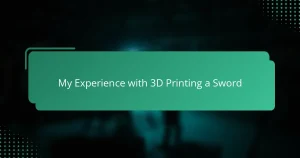Key takeaways
- Science fiction props blend imagination and craftsmanship, serving as narrative tools that embody character and story.
- The forging process involves meticulous attention to material choice, precision tools, and the detail that transforms a blade into a personalized artifact.
- Incorporating sci-fi elements, such as LED lights and unique textures, enhances the prop’s character and visual storytelling.
- The journey of crafting a prop fosters patience, a sense of accomplishment, and appreciation for the imperfections that contribute to its unique history.
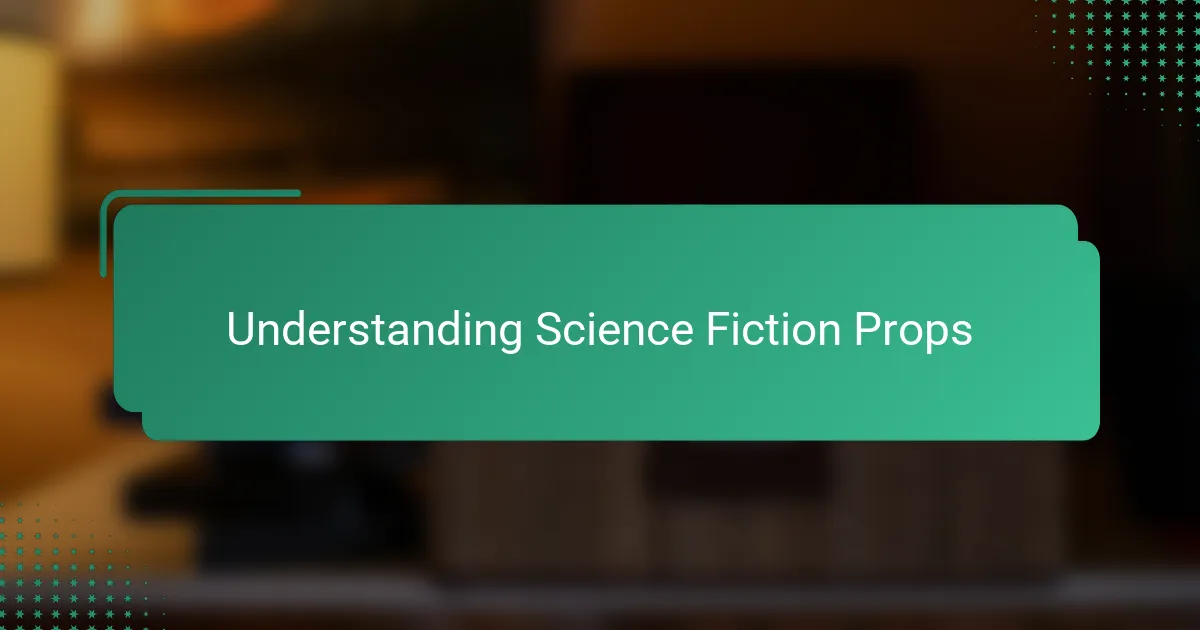
Understanding Science Fiction Props
Science fiction props are more than just visual elements; they’re gateways into entire worlds. When I first started working with these props, I realized how they shape the story’s reality and influence how we connect with characters. Have you ever held a prop that instantly transported you into another universe? That’s the magic at play.
What fascinates me is how these props balance imagination and craftsmanship. They often blend futuristic designs with practical materials, challenging creators to make something believable yet otherworldly. This tension between fantasy and functionality is what makes forging a sci-fi dagger so personally rewarding—it’s not just about looks but authenticity.
Understanding these props means appreciating their narrative power. They carry symbolism, history, and sometimes even the personality of the characters who wield them. In my own journey, every detail etched into my dagger tells a story, reflecting the essence of the sci-fi realm I’m bringing to life.
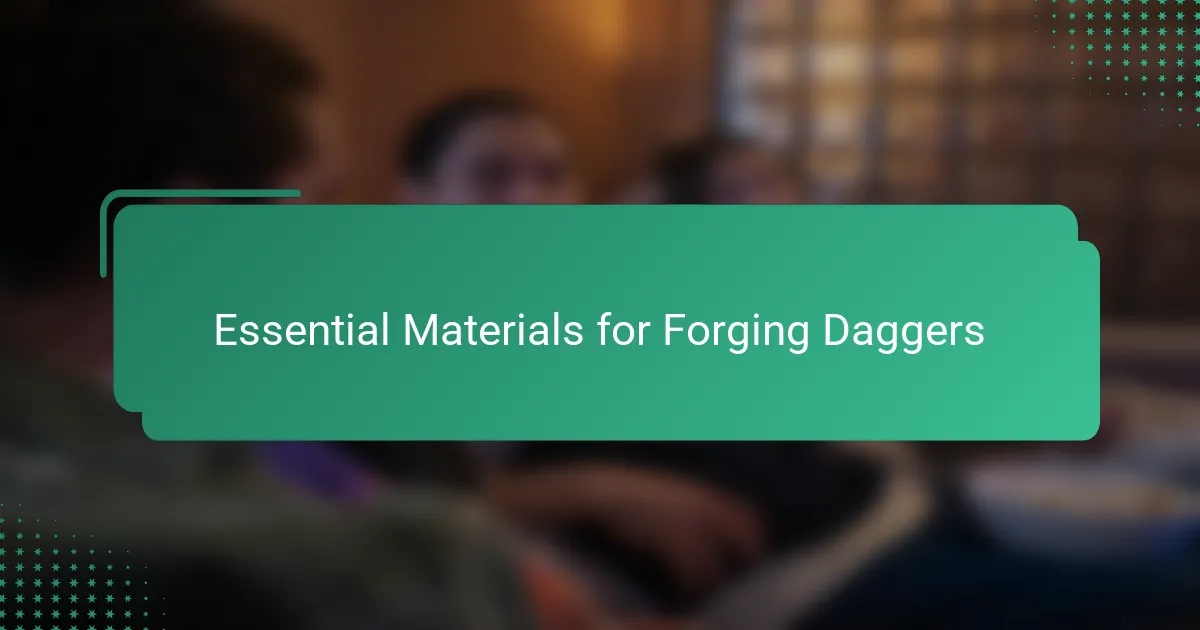
Essential Materials for Forging Daggers
Choosing the right materials for forging a dagger was one of the first challenges I faced. Steel, particularly high-carbon varieties, stood out because it offers the perfect balance of hardness and flexibility—something I quickly learned is crucial for both durability and that sleek sci-fi edge. Have you ever wondered why certain blades hold their sharpness longer? That’s the steel’s composition talking.
I also found that incorporating metals like titanium added a fascinating twist. Not only is titanium incredibly strong, but it’s lightweight, which made handling my dagger feel almost effortless—something I didn’t expect would matter until I held the finished piece. It made me think about how real sci-fi designs have to consider practicality, even in the most fantastic settings.
Beyond metals, small details mattered too. I experimented with different handle materials like wood, resin, and even leather wraps, each bringing a different feel and aesthetic. These choices shaped how I connected with the dagger, turning it from a simple blade into a personal artifact with its own story—do you think materials can carry emotional weight? For me, they absolutely do.
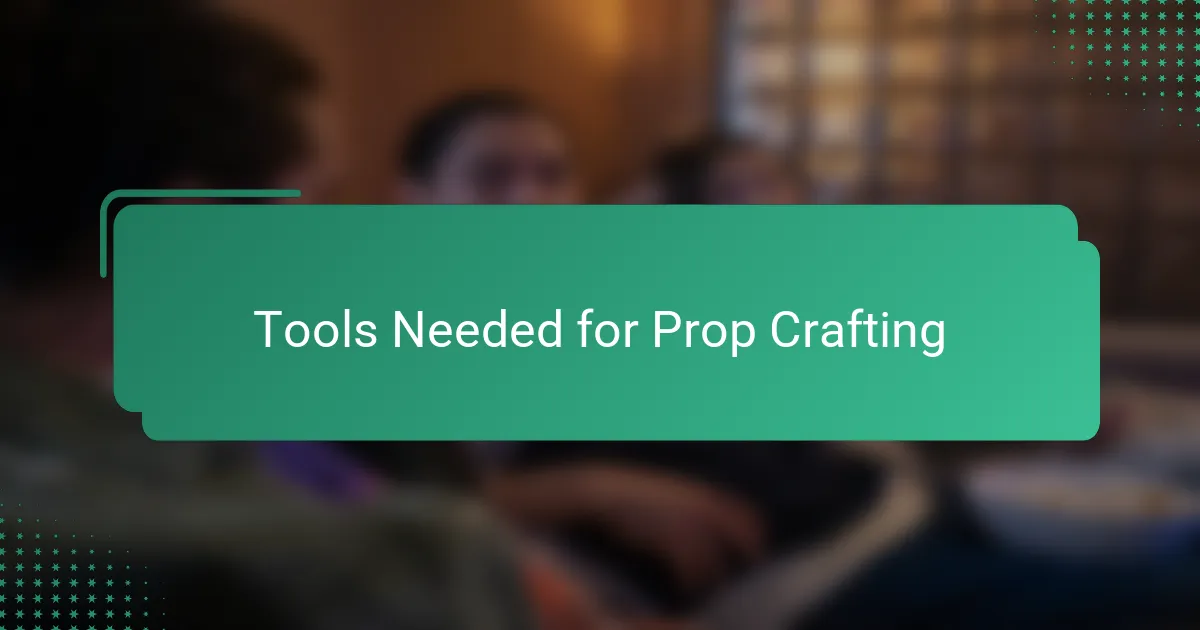
Tools Needed for Prop Crafting
Tools are the backbone of any prop crafting project, and choosing the right ones can make all the difference. When I first started forging my sci-fi dagger, I quickly learned that basic metalworking tools like a forge, anvil, and hammers were non-negotiable. Without them, the entire process felt daunting and almost impossible.
What surprised me most was how much precision tools mattered. I invested in files, grinders, and sanders to refine the blade’s edges and details—only then did my vision start coming to life. Have you ever worked on something where a tiny change in texture completely transformed the look? That’s the power of having the right finishing tools at your fingertips.
Of course, safety gear was another essential part of my toolkit that I initially overlooked. Wearing gloves, eye protection, and a respirator wasn’t just about following rules—it became a way to respect the craft and protect myself during long sessions. Protecting the craftsman is as important as creating the craft itself, wouldn’t you agree?
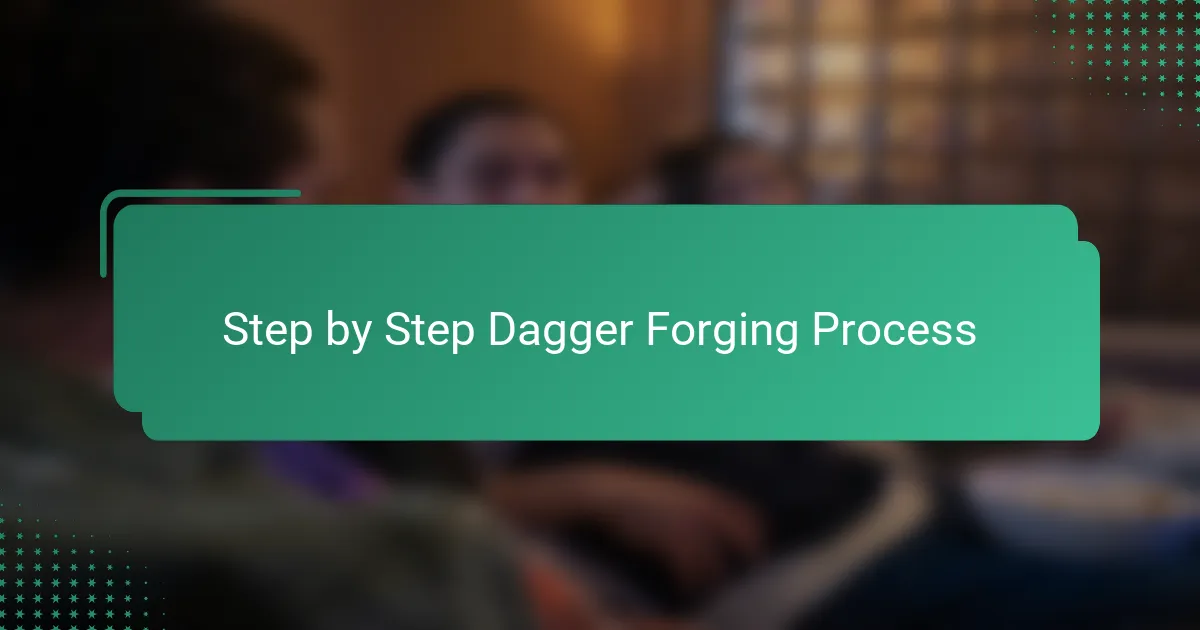
Step by Step Dagger Forging Process
The very first step in forging my sci-fi dagger was heating the steel to the right temperature—glowing orange, soft enough to shape but not melting away. I remember feeling a mix of excitement and nervousness as I hammered the metal, each strike slowly revealing the blade’s emerging form. Have you ever noticed how something raw and rough can transform into a precise shape through steady effort? That moment hooked me on forging.
Next came the crucial phase of shaping the blade with repeated heating and hammering, followed by careful grinding and filing to perfect the edges. It was in these quiet, focused sessions that I realized forging is as much about patience as it is about skill. Every small detail mattered, and I found myself thinking about the stories my dagger would tell through its curves and sharpness.
Finally, the finishing touches brought the sci-fi vision to life—polishing the blade to a mirror finish, etching intricate designs, and assembling the handle with materials that felt right to me. This part felt deeply personal, almost like breathing character into an object. Don’t you think the last details are what truly make a prop feel alive? For me, those finishing moments made all the difference.

Adding Sci-Fi Elements to the Dagger
Adding sci-fi elements to my dagger was where imagination truly took the driver’s seat. I chose to incorporate LED strips hidden along the blade’s spine, giving it that subtle, otherworldly glow. Have you ever seen a simple blade suddenly come alive with light? It’s like the dagger holds a secret energy, and that effect made me feel like I had forged a weapon from another dimension.
I also experimented with textures and patterns that mimicked futuristic technology—etched circuit-like lines and geometric shapes that seemed to pulse with an invisible force. These details weren’t just decorative; they created a tactile connection to the sci-fi world I wanted to inhabit. When I ran my fingers across those engravings, I felt like I was touching a piece of advanced tech, blurring the line between fantasy and reality.
Choosing colors was another exciting challenge. I mixed metallic paints with subtle iridescent hues to catch the light differently depending on the angle. It reminded me of the shifting nature of sci-fi itself—always changing, always unexpected. Doesn’t that kind of visual storytelling elevate a simple prop into something truly unforgettable? For me, those choices transformed the dagger from a tool into a character all its own.
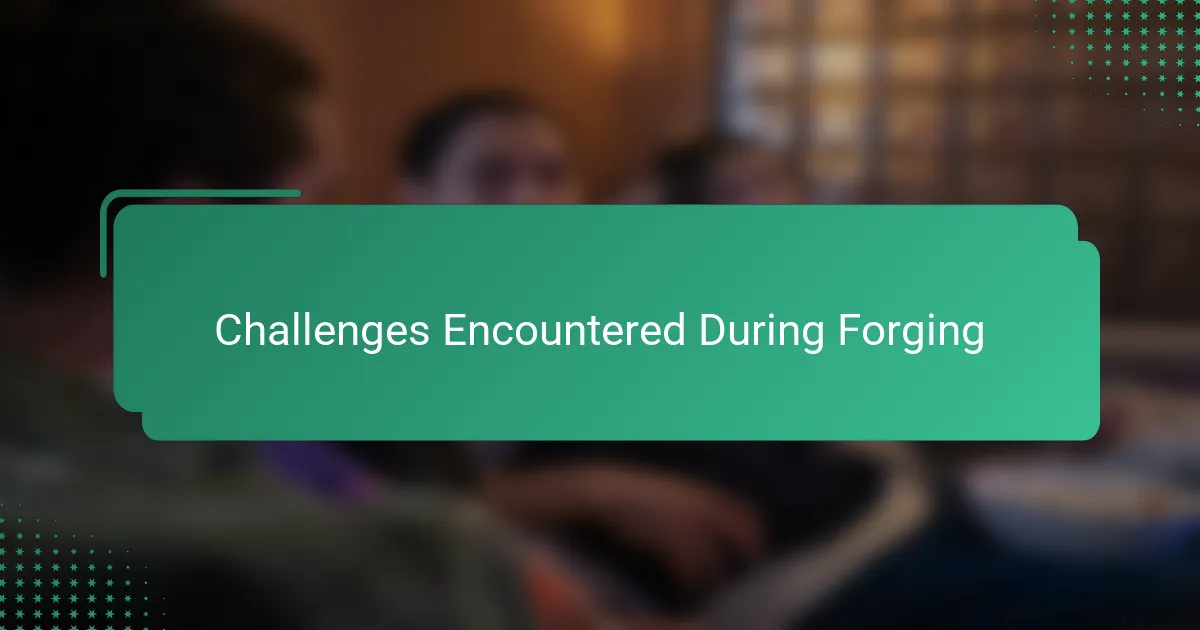
Challenges Encountered During Forging
One of the toughest challenges I encountered during forging was controlling the heat precisely. Too hot, and the metal would warp or lose its integrity; too cool, and it wouldn’t shape properly. I remember moments when I had to stop and wait as the forge slowly reached that perfect glowing orange—patience became more important than ever.
Another struggle was managing the balance between strength and flexibility. I experimented with different steel types, trying to avoid a blade that was too brittle or too soft. It felt like walking a tightrope, constantly adjusting my technique based on how the metal responded under the hammer. Have you ever faced a task where the material seems to have a will of its own? That was definitely the case here.
Finishing the dagger proved surprising as well. The tiniest imperfections stood out under the polishing light, and sanding felt endless. Each scratch I smoothed away brought me closer to the vision I had, but it also tested my resolve. At times, I questioned if perfection was even achievable—or if that very imperfection was part of the dagger’s story. What’s your take on chasing flawlessness versus embracing character in handcrafted work?
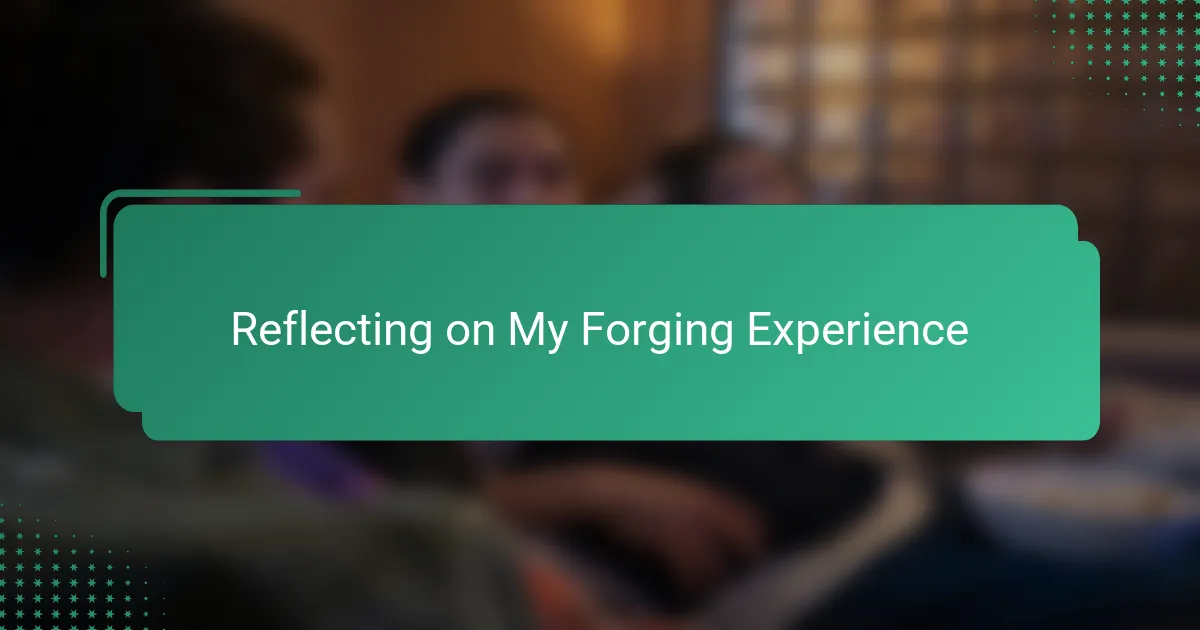
Reflecting on My Forging Experience
Looking back on my forging experience, I realize it was as much a journey of patience as it was of technique. There were moments when frustration bubbled up—especially when the blade didn’t respond as I hoped—but each setback taught me something new about the metal and myself. Have you ever found that struggle deepens your connection to a project? That certainly happened for me.
I also noticed how the process forged more than just a dagger; it forged a sense of accomplishment and respect for the craft. The thrill of seeing raw steel transform into a detailed sci-fi prop made all the aching hands and late nights worthwhile. Reflecting on this, I’m struck by how creating something tangible out of imagination feels incredibly fulfilling—don’t you think there’s magic in that?
Finally, I’ve come to appreciate the subtle imperfections that tell the dagger’s story. Rather than chasing flawless perfection, I learned to embrace the character those tiny marks offered, giving the piece a sense of history and personality. It made me wonder: does a prop become truly alive only when its maker’s journey is etched into every curve and edge? For me, that’s the heart of what prop crafting is all about.


